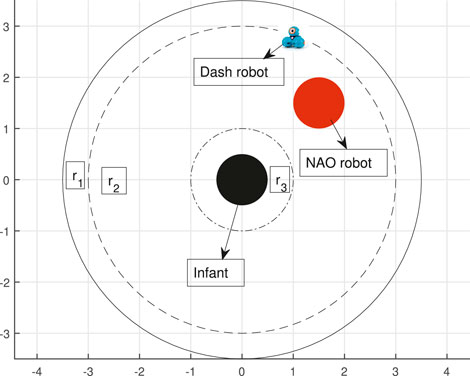Non-Smooth Control Barrier Navigation Functions for STL Motion Planning
- Department of Mechanical Engineering, University of Delaware, Newark, DE, United States
This paper reports on a new approach to Signal Temporal Logic (STL) control synthesis, that 1) utilizes a navigation function as the basis to construct a Control Barrier Function (CBF), and 2) composes navigation function-based barrier functions using nonsmooth mappings to encode Boolean operations between the predicates that those barrier functions encode. Because of these two key features, the reported approach 1) covers a larger fragment of STL compared to existing approaches, 2) alleviates the computational cost associated with evaluation of the control law for the system in existing STL control barrier function methodologies, and 3) simultaneously relaxes some of the conservativeness of smooth combinations of barrier functions as a means of implementing Boolean operators. The paper demonstrates the efficacy of this new approach with three simulation case studies, one aiming at illustrating how complex STL motion planning specification can be realized, the second highlights the less-conservativeness of the approach in comparison to the existing methods, and another that shows how this technology can be brought to bear to push the envelope in the context of human-robot social interaction.
1 Introduction
As soon as an infant starts moving she begins to perceive the world in fundamentally different ways (Higgins et al., 1996). This is because children’s spatial knowledge (how to move in space, avoid obstacles, estimate distances, find hidden objects, and decide which surfaces can bear weight) depends on their ability to locomote (Campos et al., 2000; Clearfield, 2004). Infants make mental models by computing spatial relations between their own body and other moving objects (Goksun et al., 2010). Children with motor disabilities are therefore at a developmental disadvantage. Access to power mobility is typically available after the age of 4 or 5 and without early intervention, most of these children will have permanently lost the constant and daily richness of the early years. Infant motor delays can thus have lifelong social and economical consequences, not only for the families, but also for the society as a whole.
In robotic-assisted enriched pediatric rehabilitation environments for infants with motor disabilities, our group has been utilizing robots as a means of encouraging infants to stay engaged in active game-play, in which they explore their environment as well as the capabilities of their own bodies (Kokkoni et al., 2020). In the context of this type of human-robot interaction, preliminary work (Zehfroosh et al., 2017; Zehfroosh and Tanner, 2019) has offered some evidence that in this context, appropriate and effective robot reactions to children behavior are modeled more effectively by temporal (as opposed to static, propositional) logic. In contrast to other branches of temporal logic that like Linear Temporal Logic (LTL), STL is interpreted over continuous-time signals (Maler and Nickovic, 2004) while still capturing timing constraints associated with complex tasks. This feature makes STL an even more appropriate choice for defining robot tasks within time-limited pediatric motor rehabilitation sessions.
Motion planning with STL specifications is known to be hard and usually leads to computationally demanding solutions (Lindemann and Dimarogonas, 2018). The starting thread of work on STL motion planning relies on a computationally demanding mixed-integer linear programming process (Raman et al., 2014; Sadraddini and Belta, 2015; Liu et al., 2017). The computational complexity of these methods makes real-time implementation particularly challenging, especially in the presence of dynamic obstacles (Gundana and Kress-Gazit, 2021). Not surprisingly, Jones et al. (2019) pre-compute the control before execution to overcome real-time implementation issues, at the cost of sensitivity to run-time disturbances.
Lindemann and Dimarogonas (2018) reduced the computational burden of STL motion-planning through a CBF based methodology (Ames et al., 2019). Their method can account for a fragment of STL that includes conjunctions in the predicates or the temporal operators. The control design involves the solution of a Quadratic Programming (QP) problem at each motion planning step. Subsequent extensions of this CBF-based STL motion planning method were made along the directions of multi-agent systems with conflicting local specifications (Lindemann and Dimarogonas, 2019a), and dynamically coupled multi-agent systems (Lindemann and Dimarogonas, 2020).
In this existing STL control design framework, combining predicates and encoding them by (smooth) CBFs introduces a degree of conservatism. This is because of the way the CBF that incorporates the different predicates is constructed, as an exponential summation of component CBFs. Interestingly, one can compose CBF using nonsmooth operators (Glotfelter et al., 2017). Naturally, this comes at the cost of introducing a level of analytical complexity that makes analysis and control design more challenging. Nonsmooth CBFs formulations now exist for time-varying problem instantiations, where different predicates are combined in the form of pointwise minima and maxima of sets of component CBFs (Glotfelter et al., 2019).
Nonsmooth CBFs can relax the conservativeness of predicate composition, but currently share the same method for computing control laws as do smooth CBFs for STL motion planning synthesis (Glotfelter et al., 2017), i.e., solving a QP problem at each iteration of the control loop. Currently, the only STL motion planning method that circumvents the computational burden of solving a optimization problem at every iteration is the funnel-based procedure that provides continuous-time control laws (Lindemann et al., 2017; Lindemann and Dimarogonas, 2019b, 2021). The downside of the aforementioned approach is that it covers a much smaller fragment of STL
This paper is the first to utilize nonsmooth CBFs in STL motion planning and control, circumventing, at least in part, computational control design problems by utilizing navigation functions (Rimon and Koditschek, 1992). Within this new framework, the reported methodology provides directly closed-form control laws that result in a feasible and safe robot paths. This new method 1) considerably alleviates the computation burden related to the solution of a QP optimization problem for attaining control input at every time step, 2) covers a larger class of STL (those that include disjunctions) compared to the existing barrier-function based methods and 3) relaxes some of the conservatism associated with existing CBF composition operations by under-approximating of the minimum operator for the sake of smoothness. What is more, the proposed method allows the incorporation of both attractive and repulsive for the system regions within the same analytical expression, thus reducing the size of the STL specification for a desired task. For clarity of exposition, the present paper describes the methodology as it applies to sphere world environments, with pathways to extensions to star world (Li and Tanner, 2018), as well as time-varying robot workspaces (Sun and Tanner, 2015; Chen et al., 2020) readily available.
The rest of this paper is organized as follows: It starts by some technical preliminaries on both STL semantics and non-smooth CBF. Section 3 introduces the problem of interest in the paper by specifying the fragment of STL specifications that motion planning need to be done for. Control barrier navigation functions are presented in Section 4 as a solution to the problem, where both their construction steps as well as the control input computation procedure are elaborated. Finally, Section 5 offers simulation results that illustrate the performance of the technical approach.
2 Technical Preliminaries
This section introduces necessary mathematical background needed for the subsequent technical discussion. The section briefly reviews STL non-smooth CBFs, and some known results that will be utilized in following sections. Before these concepts are introduced, let us present the technical terminology for the systems at hand. To that end, let
and assume that functions
When every solution to (1) which starts in a set stays there, then this set is said to be forward invariant relative to (1). Specifically, we say that a set
There can be cases where the (closed loop) right hand side of (1) needs to be discontinuous in x—and therefore cannot be locally Lipschitz. In these cases, both the expression of dynamics, as well as the trajectories of the system, need to be understood in a more general sense. One option for expressing dynamics with input discontinuities is by utilizing differential inclusions expressed in the form of the Filippov set-valued map, where one would write F [⋅]
using
The solutions of (2) can be understood in a number of ways, and are generally not unique. One notion of solution is in the sense of Carathéodory; if the Filippov set is nonempty, compact, and convex, and the set-valued map x↦F (t, x) is upper-semicontinuous while the set-valued map t↦F (t, x) is measurable, then it is known that such Carathéodory solutions for (2)exist (Bacciotti and Rosier, 2005). A Carathéodory solution to (2) on an interval
2.1 Signal Temporal Logic
Signal temporal logic (STL) is a temporal logic formalism that involves logical predicates, denoted μ, whose truth values are evaluated over continuous signals. In this particular case, the continuous signals are the system’s state trajectories at time t, namely x(t). The predicates assume their logical valuates based on a (continuous) predicate function
Based on such predicates, an STL formula φ can be recursively defined as
where
If a solution
2.2 Nonsmooth Control Barrier Functions
A CBF enables controller synthesis for dynamic systems in a way that ensures that if the system starts inside a set, it will never leave that set, rendering the set forward invariant with respect to the dynamics of system. A CBF can characterize the set of allowable control inputs that guarantee forward invariance of certain regions for a dynamical system at hand. The required control input is picked from a set defined in terms of the CBF for example by solving an optimization problem in a sampled-data fashion (Ames et al., 2016).
Nonsmooth CBFs allow more flexibility in the encoding of state constraints and specifications compared to their smooth counterparts. The utilization of such functions typically leads to consideration of the dynamics of the system in the form (2), primarily due to the discontinuities introduced by the control law u when it depends on the gradient of a nonsmooth CBF In fact, since the latter are nonsmooth, their gradient cannot be defined everywhere in the usual way. At points of nondifferentiability, one can understand their gradient as a set, rather than a singleton vector, and express it using the concept of the generalized gradient, which in finite dimensional spaces enjoys the following concrete characterization as Theorem 1
THEOREM 1. [(Clarke, 1990, Theorem 2.5.1)]. Consider a locally Lipschitz function
Examples of nonsmooth functions include the point-wise minimum or maximum of a finite collection of locally Lipschitz functions. Indeed, these specific nonsmooth functions are of particular interest in the context of STL synthesis because they can capture the conjunction and disjunction of a number of predicates, when each of the latter is expressed by its own component CBFIn particular, suppose
with equality holding if
with equality holding now if
The following lemma (Lemma 1) links time derivative of function
LEMMA 1. [cf. (Glotfelter et al., 2019)]. Consider a Carathéodory solution
For a locally Lipschitz scalar function
Now the notion of forward invariance can be linked to the concept of CBF through the following definition (Definitions 1,2):
DEFINITION 1. [cf. (Glotfelter et al., 2017, Def. 4) and (Lindemann and Dimarogonas, 2018, Def. 3)]. A continuous scalar function
DEFINITION 2. [cf. (Glotfelter et al., 2017, Def. 3) and (Lindemann and Dimarogonas, 2018, Def. 2)]. A continuous candidate nonsmooth CBF
for all Carathéodory solutions of (2) starting from x (0).The following theorem gives a useful equivalent condition for a valid CBF
THEOREM 2. [cf. (Glotfelter et al., 2017, Thm. 2)]. Let
then
COROLLARY 1. A candidate non-smooth CBF
In other words, for a valid non-smooth CBF there is always a control input u to make the set
3 Problem Statement
This paper considers the following fragment of STL
where formulae ψ1 and ψ2 are of the type defined in (10a), and formulae φ1, φ2 are of the type defined in (10b). This is a larger class of STL compared to Lindemann and Dimarogonas (2018) as it allows for disjunctions in the predicates or the temporal operators.
We make similar assumptions (Assumptions 1,2) on the trajectories and the nature of the term g(x) in (1):
ASSUMPTION 1. (Lindemann and Dimarogonas (2018)). For an STL formula φ as defined by (10b), there exists a constant C ≥ 0 such that (x, 0)⊧φ ⇒ ‖x(t)‖ ≤ C ∀ t ≥ 0.In other words, satisfaction of formula φ guarantees a bounded trajectory.
ASSUMPTION 2. [Lindemann and Dimarogonas (2018)]. The vector function g(x) in (1) is such that g(x)g(x)⊺ is positive definite for all
PROBLEM 1. Find an input control law u(x, t) that guarantees the solution(s)
4 Technical Approach
This section introduces a time-varying and nonsmooth CBF that is constructed following the original principles of navigation functions set forth by Rimon and Koditschek (1992). The reported construction leverages the navigation function properties of the CBF to yield a direct method for obtaining the control law u in (2) that is guaranteed to satisfy the desired STL specification.
4.1 Navigation Functions as Control Barrier Functions
This section borrows primarily from Sun and Tanner (2015), based on the foundation of sphere world navigation functions of Rimon and Koditschek (1992), to construct a time-varying CBF with navigation function properties. While Sun and Tanner (2015) allow for time-varying destination configurations, and Chen et al. (2020) consider time-varying obstacle locations, here the construction of the navigation function component of the CBF is itself time-invariant, just as in the original methodology (Rimon and Koditschek, 1992), although time-varying extensions appear plausible (Sun and Tanner, 2015; Chen et al., 2020).
An STL specification consists of logical predicates μ as in (3) that can be interpreted as different regions of interest in the state space of the dynamical system at hand, which need to be visited or avoided at particular time periods. Working in a sphere world, all regions of interest (those that a robot needs to approach or those it needs to avoid) are assumed to have spherical shapes. This assumption does not limit the generality of the approach since both Rimon and Koditschek (1992) for the time-invariant case, as well as Li and Tanner (2018) for the case of time-varying destinations, show that diffeomorphic transformations can extend navigation function properties from sphere to (forests of) star worlds.
The key feature of the construction of Sun and Tanner (2015) that is adopted here is the non-point destination. Specifically, instead of the target of navigation being the convergence to a single point, Sun and Tanner (2015) allow for a destination manifold in the shape of a spherical shell, which is the zero level set of the function
which serves as the predicate function encoding logical predicate μi. In the above, one distinguishes the predicate function’s center
where
where xws and rws stand for the center and radius of the workspace, respectively. Given these constructs and the fact that all obstacles are assumed to be disjoint, the combined obstacle representation can take the form
and with that, a navigation function ϕi(x) can be explicitly constructed for predicate μi as
with κ = 2n for
The following examples illustrate how (12) can be used to construct a time-varying nonsmooth CBF
EXAMPLE 1. Consider the STL formula φ = ♢[a,b]μ1. If ϕ1(x) is defined as in (12) with hi(x) being the predicate function for μ1, then a CBF that captures φ as a specification can be constructed in the form
EXAMPLE 2. Consider the STL formula φ = φ1 ∧ φ2 where
EXAMPLE 3. Consider the STL formula φ = φ1 ∨ φ2 where φ1 and φ2 are as in Example 2. CBFs
4.1.1 STL Specifications With no Conjunctions and Disjunctions
This section describes how to construct a CBF for an STL specification that does not involve conjunctions and disjuctions of predicates and temporal operators.
If this STL specification in question is of the form ♢[a,b]μ1 then the CBF can be constructed as
where
If the specification has the form □[a,b]μ, the CBF can have the same general form
The remaining case refers to specifications of the form μ1 U[a,b] μ2, for which the CBF is constructed as
Where once again
4.1.2 STL Specifications With no Conjunctions or Disjunctions Between Temporal Operators
This section refers to STL specifications that may have conjunctions and disjunctions involving predicates but not temporal operators. We assume that the formulae inside a temporal operator has been written in Conjunction Normal Form (CNF), i.e.,
Then if the specification has the form ♢[a,b]ψ1, the CBF can take the form of
Where each
For specifications of the form □[a,b]ψ1, the CBF can be similarly constructed based on (15) with component CBFs as in (13), but this time each
Finally, for specifications involving the Until operator and of the form ψ1 U[a,b] ψ2, the CBF can be formed as
where all component CBFs
4.1.3 General Case of STL Specifications
Combining the constructions of Sections 4.1.1, 4.1.2, one is now in position to form CBF for more general STL specifications in the fragment defined in (10). Again, we assume that the STL specification is written in CNF with respect to the temporal operators. As an illustrative example, consider the case of
In addition to the ability to cover STL specifications including disjunctions, the construction process outlined in Sections 4.1.1–4.1.3 generally yields less conservative CBFs compared to the method of Lindemann and Dimarogonas (2018), because the latter introduces some conservativeness through its exponential summation to combine the component CBFs (see Section 5.2); the perceived benefit of this latter construction is that it preserves the differentiability properties of the CBF and circumvents the need for nonsmooth analysis. What is more, the computation process described here can be further accelerated by adopting the deletion mechanism of Lindemann and Dimarogonas (2018), whereby a component CBF
4.2 Efficient Determination of the Control Input
Section 4.1 primarily illustrated how the use of navigation functions and pointwise minimum functions can allow the construction of CBFs that tightly encode STL specifications in the fragment defined by (10). This section focuses on demonstrating that control design can also be facilitated due to the navigation function properties afforded by the proposed component CBFs.
Without loss of generality, let p be the total number of predicates and q be the total number of temporal operators appearing in the STL specification. For j ∈ {1, … , q}, and with the formulae inside the temporal operators written in CNF (Section 4.1.3), then temporal operator indexed k will be modelled by a CBF of the form
For some distinct kj, lj, mj, nj ∈ {1, … , p}. Then the temporal operators of the STL formula can themselves be arranged in CNF (Section 4.1.2), in which case the composite (total) CBF capturing the complete STL specification would take a similar compact form
For some other distinct k, l, m, n ∈ {1, … , q}, with the understanding of each one of the
Then the control input u that guarantees that
4.2.1 When the CBF is Differentiable at x
When the CBF is differentiable at point x, the set J is a singleton. Without loss of generality assume that at that time t, it is J (x, t) = {1}. Then the control input u (x, t) to guarantee
Where k should be selected such that the following condition, involving an extended class-
Therefore, k can be selected as the maximum between zero and the solution of the equation
A solution to (20) exists almost everywhere since g(x)g(x)⊺ is assumed to be positive definite (by Assumption 2) and
and the latter is guaranteed to be non-zero almost everywhere away from the level set of hj (with the exception of a finite number of isolated points). Note that negative solutions for k can be safely discarded, since the trivial choice of k = 0 would still satisfy (19) and offer an admissible control law with an even smaller (than the negative k) norm. Given that in the case considered in this section, (5–8) reduce to singletons,
4.2.2 When the CBF is not Differentiable at x
At configurations x where a CBF is not differentiable, one of the following two cases can occur: precisely two component CBFs agree with the value of
When just two component CBF agree with the value of
For (21) to hold, it is sufficient that the following two inequalities are simultaneously satisfied:
Assume now a control law of the form
Where the control gains k1 and k2 are determined as the maximum between zero and the solutions to the following system of algebraic equations:
The above system of equations always has a unique solution except when
Note that the solution to the above QP coincides with the input derived from (5–8) and Theorem 2.
The case when J contains two members does not generalize to instances where more than two component CBFs agree with the value of
Note that (19), (22) and the optimization constraint in (25) are all equivalent versions of (9) for the cases when J = {1}, J = {1, 2} and general form of J, respectively. According to Theorem 2, then the barrier function will be valid and consequently by Definition 2, it means that if the system starts where
Note that the existing closed-form solutions to the CBF-based QP only apply to time-invariant safe sets (Ames et al., 2016). This time-invariance is not conducive to STL planning, that often requires that safe sets to change over time. This is why the existing CBF-based STL planning methods (Glotfelter et al., 2017; Lindemann and Dimarogonas, 2018) discretize time and employ QP iteratively in the control loop with an additional assumption [Assumption 3 in Lindemann and Dimarogonas (2018)] on the barrier function to explicitly accommodate safe sets that shrink over time. In contrast, and excluding the singular cases that are dealt by (25), the general process for determining the CBF-based control law outlined above, provides computational benefits because it obviates (25) in all but a very small subset of time steps where the CBF is not differentiable (see Section 5.1).
The following proposition (Proposition 1) states that the control law designs of (18) and (23) are in fact the minimum-norm input that satisfied the required conditions (19) or (22), and thus coincide with the solution of (25). Consequently, when the solutions given by (18) or (23) fail to satisfy an actuation bound, this in fact means that the problem is infeasible in this CBFs framework, given the actuation constraints.
PROPOSITION 1. The control laws (18) and (23) give the minimum-norm inputs that satisfy (19) and (22), respectively.
PROOF. We prove the claim for (18); the process for (23) is a mirror image. Let u* be the minimum-norm control input that satisfies (19). By contradiction: assume that u of (18) is such that ‖u‖ > ‖u*‖. Then both the following conditions should be satisfied:
The first equation is the consequence of choosing coefficient k according to (20). Given now that u is by construction aligned to the vector
5 Simulation Results
This section is organized in three parts. The objective of the first part, which is Section 5.1, is to demonstrate the capabilities of the reported nonsmooth CBF utilizing a relatively complex STL specification. The second part, i.e., Section 5.2, is to show the less-conservatism of the offered method in comparison to Lindemann and Dimarogonas (2018). The third part, Section 5.3, is to illustrate how the reported technology can be applied in the context of robot-child interaction for pediatric motor rehabilitation purposes within an enriched environment where robots socially interact with infants, thus linking back to the motivating application that opened up Section 1.
5.1 Robot Motion Planning With Complex STL Specifications
Consider a robot in a 2D spherical workspace of radius 1, initially positioned at a configuration with coordinates x0 = (0.9,0.2)⊺ and with dynamic
In addition to avoiding obstacles, the robot has an array of mission objectives associated with different (spherical) regions of interest in its workspace. These mission objectives will naturally be expressed in STL In general, we will denote μi the predicate that is associated with the ith region of interest. Table 1 collects the topological information of the different regions of interest for the robot.
The STL task specification that the robot needs to satisfy is given in the following form:
Using the construction process outlined in Sections 4.1.1–4.1.3, the barrier function for (27) is as follows:
Note that while
Figure 1 gives successive snapshots of the robot’s path through the workspace, as it is steered by the control law computed based on the process outlined in Section 4.2. The time instances associated with the snapshots showcased correspond to representative moments in relation to the temporal operators appearing in the STL specification φ1 in (27). First of all, as a result of maximum operator, visiting (μ1 ∨ μ2) at t = 3 is preferred over visiting μ3 since the former is much closer to the initial location of the robot. For the same reason, between μ1 and μ2, the former is selected to be visited at time t = 3. It should continue to remain inside the union of μ1 and μ2 (to ensure (μ1 ∨ μ2) remains true) from t = 3 until t = 7, which is verified in the sequence of subsequent snapshots at times t = 3, t = 5, t = 6, and t = 7. Meanwhile, however, and sometime in the [4, 5] time interval, the intersection of μ2 and μ3 must be visited (to make (μ2 ∧ μ3) true), a fact that is evident in the top left snapshot for t = 5 where the robot is shown to make a maneuver to the left to reach the intersection of μ2 and μ3. Then, the specification φ1 indicates that in the [6, 10] time interval predicate μ4 should first be satisfied before predicate μ5 becomes true. Indeed, the robot is shown at t = 6 to have touched the boundary of μ4; following that, at time instant t = 10 the robot is shown to have touched the boundary of μ5. While all these maneuvers take place, the robot always stays clear of the static obstacle, marked in Figure 1 with the solid red disk.
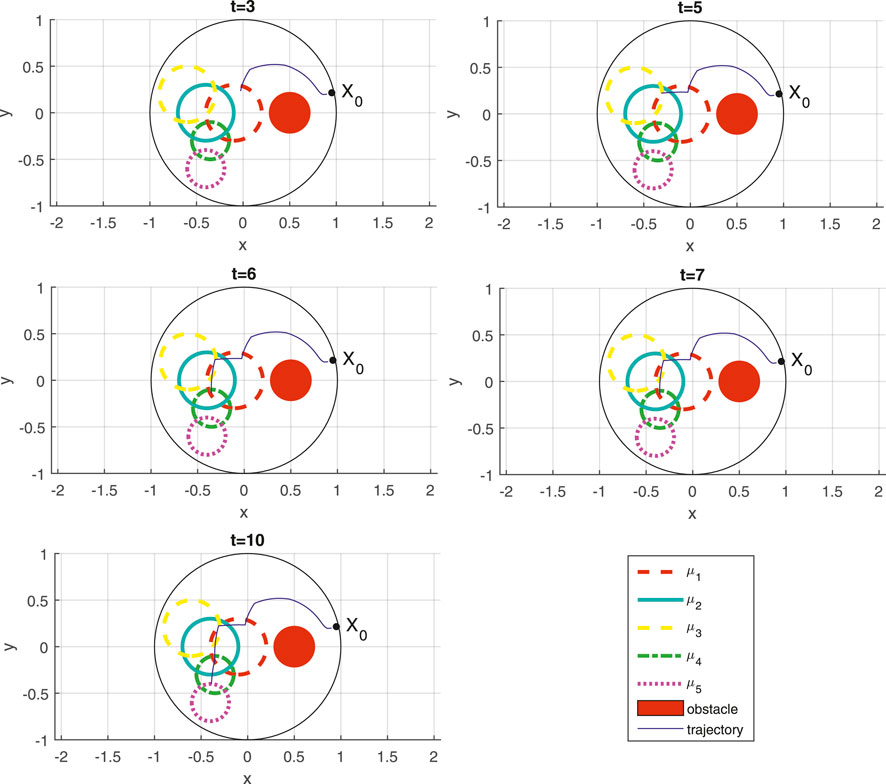
FIGURE 1. Path of the robot as it is controlled to satisfy STL task specification φ1 (27) with snapshots at different time instances; the time instant is indicated at the top of each subfigure.
Figure 2 presents graphs that show the evolution of the two-dimensional control input u (x, t) that implements the STL task specification (27). As Figure 2 indicates, the control inputs experience discontinuities. Not surprisingly, several jumps occur at time instants coinciding with non-differentiable points of the barrier function.
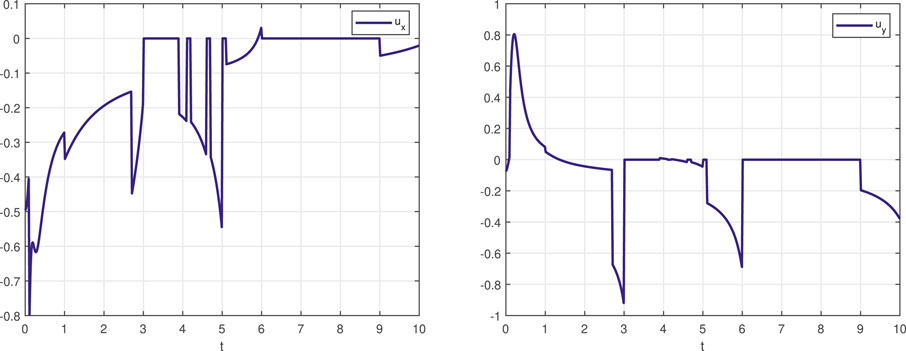
FIGURE 2. The control input signal (ux left, uy right) that realized the STL task specification φ1 expressed in (27).
To see better the computational savings of this method compared to approaches that required the repeated solution of the QP program for the determination of the control law, the time interval [0, 10] of the STL task (27) was discretized to 1,000 time steps. Among those, only 17 featured J (x, t) with cardinality two, while there were zero instances where |J (x, t)| > 2. Of those 17 time steps, which show as the non-differentiable points of the barrier function depicted in Figure 3, none of them marked a singular case; consequently, (23) applies to them all, and (18) used everywhere else. Therefore, in handling the STL task (27), the reported method never resorted to solving a QP problem.
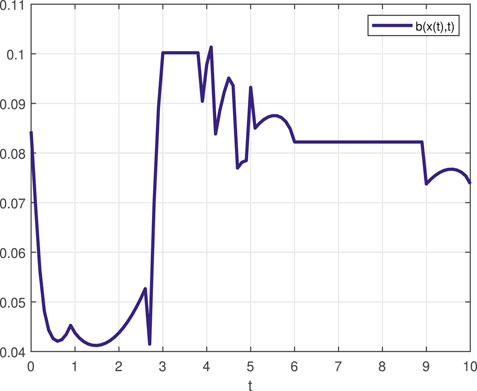
FIGURE 3. Control barrier function
5.2 Evidence of Conservatism Relaxation
This section includes an illustrative example that demonstrates how less conservative the presented solution can be [even for the smaller STL class considered by Lindemann and Dimarogonas (2018)] when satisfying STL specifications, specifically in cases where smooth formulations do not permit the satisfaction of these specifications.
Consider a robot in a 2D spherical workspace of radius 3, initially positioned at a configuration with coordinates x0 = (−2,1)⊺. The STL specification of the robot’s mission in this workspace involves visiting two regions of interest whose topological information is presented in Table 2.
The STL task specification that the robot needs to satisfy is given in the following form:
Within a smooth STL composition framework, planning for satisfaction of (29) proceeds as follows (Lindemann and Dimarogonas, 2018): 1) first one defines predicate functions h1 = 1 − ‖x‖ and h2 = 1 − ‖x − (1.5,0)⊺‖ for regions μ1 and μ2 respectively; 2) then the barrier function for each sub-formula of (29) is constructed as
This process renders (29) not satisfiable. To see this, focus on the time interval t ∈ [2, 3] when the robot needs to visit and remain in the intersection of μ1 and μ2. Note that in this time interval, there must be γ1(t) ≤ 1 and γ2(t) ≤ 1 to ensure
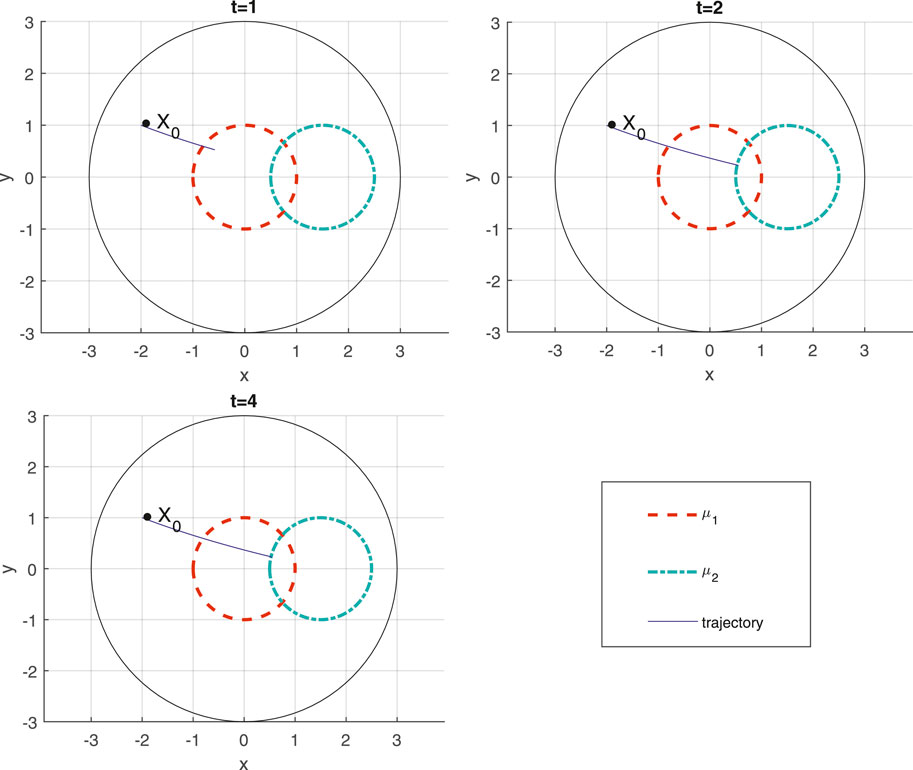
FIGURE 4. Trajectory of the robot for STL task φ2 (29) at different time instances, with time label at the top of each figure.
5.3 Application to Robot-Child Interaction
This section demonstrates how the nonsmooth CBF theory can be applied in the context of early pediatric motor rehabilitation, to regulate play-based social interaction between infants and mobile robots. The primary clinical objective of these mobile robots is to encourage infant mobility through interactive gameplay. Figure 5 shows an (enriched, in terms of stimuli) robot-assisted motor rehabilitation environment for infants involving two robots engaged in free-play activities with an infant.
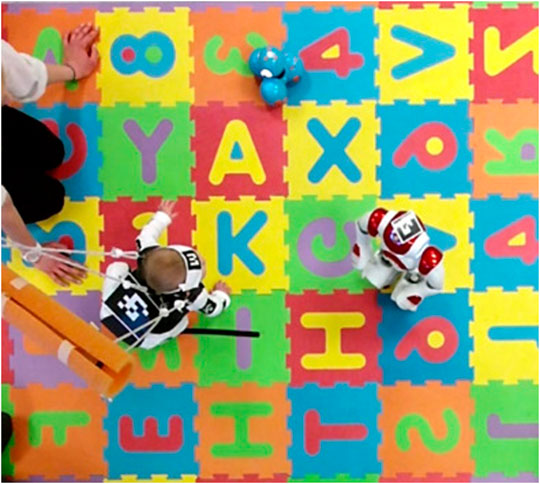
FIGURE 5. Instance of play-based child-robot social interaction. Two robots are visible in the scene: a small humanoid Nao, and a differential-drive small mobile robot toy Dash.
The robots shown Figure 5 have been remotely controlled during the studies conducted, with the operators following a pre-determined look-up table of appropriate robot responses to infant reactions. Similar to other instances of Human Robot Interaction (HRI) application reported in literature (McGhan et al., 2015; Zehfroosh et al., 2017), a Markovian model is used to model the interaction at the high level. The parameters of this Markovian model are learned through observations in sessions with human subjects (Zehfroosh et al., 2017). Synchronized video from a network of surrounding cameras provided input to action recognition machine learning algorithms capable of identifying certain infant behaviors of interest, such as walking, crawling, standing, sitting, etc., as well as transitions between them (Kokkoni et al., 2020). In an envisioned fully automated version of this robot-assisted rehabilitation environment, robots could receive direct feedback regarding the child’s reactions and adapt their gameplay behavior accordingly in order to further encourage infant mobility.
In specific gameplay scenarios involved in the HRI protocol followed, infants and robots were playing a game of tag, in which the robot had a small set of options with regards to its play-based interaction with the child: close the distance to the infant; increase the distance to the infant; stand still (Kokkoni et al., 2020). Analysis of session data from a small number of subjects seemed to point to a new hypothesis according to which the type of robot behavior that usually triggers infant motor responses rarely involves single atomic actions, but is rather more complex involving several actions in temporal succession. For instance, it looked as if the robot could convey a social non-verbal cue such as “follow me” if it initially approached the child within about 1 m in distance, stood still for a short time interval, then attempted to increase the distance slightly, before repeating in a back-and-forth moving pattern. Motivated by these observations, we have subsequently conjectured that robot responses modeled in an LTL framework may be more effective in triggering the desired subject responses (Zehfroosh and Tanner, 2019). The STL framework described in this paper allows us to bring this HRI method to a new level, including timing constrains.
To see how this could work in the context of the HRI scenario of Figure 5, consider a circular 2D robot workspace for Dash at the time when the “follow me” social cue is to be given (see Figure 6). Divide this workspace into three labeled regions R = {r1, r2, r3}, with the robot initialized in region r2. The desired back-and-forth moving pattern for the “follow me” task can be encoded by a random selection of some specific subregions of interest inside r1 and inside r2. Construct now an STL specification that requires the robot to visit those regions in order and with appropriate timing. For example, for three regions defined geometrically as in Table 3,the following STL behavior specification (in the form of formula φ3) for the robot can be defined as a way to signal “follow me” within 10 s to its human playmate:
Figure 7 presents Dash’s trajectory for STL formula φ3 given in (30), realized through the nonsmooth control barrier navigation function methodology of Section 4. Just like the motion planning scenario of Section 5.1, the robot path is shown in terms of snapshots at important time instances that attempt to illustrate the satisfaction of the STL specification (30).

TABLE 3. Geometric characteristics of regions of interest for a child-robot interaction scenario. μ1 and μ3 are inside r1 and μ2 is inside r2.
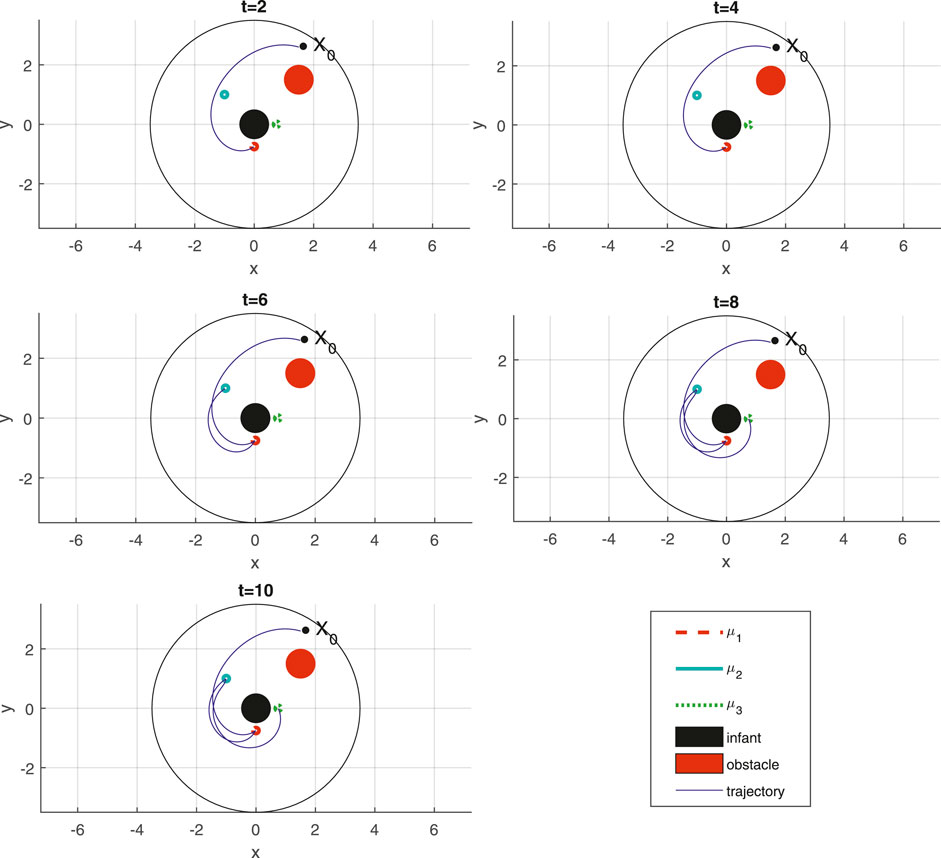
FIGURE 7. Trajectory of the Dash for STL task φ3 (30) at different time instances, with time label at the top of each figure.
6 Conclusion
By now it is known that motion planning and control synthesis STL can be facilitated through the use of the concept of the control barrier function (CBF). This process obviates the need for model checking as a means of obtaining control laws that implement an STL specification, but still comes at the cost of utilizing a restricted fragment of STL and having to solve a QP problem in each cycle of the control loop. The incorporation of navigation functions as the base for the construction of CBFs, as advocated in this paper, is shown here to be advantageous because it alleviates the computational cost of utilizing CBFs in STL control synthesis. What is more, when the CBFs are combined through nonsmooth mappings as a means of encoding Boolean logic, the construction not only allows for covering larger class of STL specifications in comparison with the existing barrier-function STL planning methods, but also relaxes the conservativeness of existing smooth compositional formulations, and allows the resulting control laws to inherit some of the performance guarantees in terms of convergence and safety afforded by feedback motion plans based on navigation functions. Finally, the nonsmooth approach to combining navigation CBFs allows to expand the fragment of STL covered so that includes disjunctions at no apparent computational cost. The methodology described in this paper can prove useful in applications where robots are called to perform complex and temporally-dependent tasks. An example of such an application, which this paper highlights, is found in the context of pediatric robot-assisted motor rehabilitation.
Data Availability Statement
The original contributions presented in the study are included in the article/Supplementary Material, further inquiries can be directed to the corresponding author.
Author Contributions
Both authors contributed equally in drafting and revising the paper. AZ conducted the simulation results in Section 5.
Funding
This research was supported in part by NIH 5R01HD87133, and in part by NSF #2014264.
Conflict of Interest
The authors declare that the research was conducted in the absence of any commercial or financial relationships that could be construed as a potential conflict of interest.
Publisher’s Note
All claims expressed in this article are solely those of the authors and do not necessarily represent those of their affiliated organizations or those of the publisher, the editors, and the reviewers. Any product that may be evaluated in this article, or claim that may be made by its manufacturer, is not guaranteed or endorsed by the publisher.
Footnotes
1A smooth version of such a function can be implemented based on the construction of Boothby (1986).
2For this to happen, the two clauses of the STL formula corresponding to
References
Ames, A. D., Coogan, S., Egerstedt, M., Notomista, G., Sreenath, K., and Tabuada, P. (2019). “Control Barrier Functions: Theory and Applications,” in 18th European Control Conference, Naples, Italy, 25-28 June 2019, 3420–3431. doi:10.23919/ECC.2019.8796030
Ames, A. D., Xu, X., Grizzle, J. W., and Tabuada, P. (2016). Control Barrier Function Based Quadratic Programs for Safety Critical Systems. IEEE Trans. Automatic Control. 62, 3861–3876.
Bacciotti, A., and Ceragioli, F. (2006). Nonpathological Lyapunov Functions and Discontinuous Carathéodory Systems. Automatica 42, 453–458. doi:10.1016/j.automatica.2005.10.014
Bacciotti, A., and Ceragioli, F. (1999). Stability and Stabilization of Discontinuous Systems and Nonsmooth Lyapunov Functions. Esaim: Cocv 4, 361–376. doi:10.1051/cocv:1999113
Bacciotti, A., and Rosier, L. (2005). Liapunov Functions and Stability in Control Theory. Berlin, Germany: Springer Science and Business Media.
Boothby, W. M. (1986). An Introduction to Differentiable Manifolds and Riemannian Geometry. Cambridge, Massachusetts: Academic Press.
Campos, J. J., Anderson, D. I., Barbu-Roth, M. A., Hubbard, E. M., Hertenstein, M. J., and Witherington, D. (2000). Travel Broadens the Mind. Infancy 1, 149–219. doi:10.1207/s15327078in0102_1
Chen, C., Li, C., and Tanner, H. G. (2020). Navigation Functions with Non-point Destinations and Moving Obstacles. Proc. IEEE Am. Control. Conf., 2532–2537. doi:10.23919/acc45564.2020.9147243
Clarke, F. H. (1990). Optimization and Nonsmooth Analysis. Philadelphia, Pennsylvania: Society for Industrial and Applied Mathematics.
Clearfield, M. W. (2004). The Role of Crawling and Walking Experience in Infant Spatial Memory. J. Exp. Child Psychol. 89, 214–241. doi:10.1016/j.jecp.2004.07.003
Glotfelter, P., Buckley, I., and Egerstedt, M. (2019). Hybrid Nonsmooth Barrier Functions with Applications to Provably Safe and Composable Collision Avoidance for Robotic Systems. IEEE Robot. Autom. Lett. 4, 1303–1310. doi:10.1109/lra.2019.2895125
Glotfelter, P., Cortés, J., and Egerstedt, M. (2017). Nonsmooth Barrier Functions with Applications to Multi-Robot Systems. IEEE Control. Syst. Lett. 1, 310–315. doi:10.1109/lcsys.2017.2710943
Göksun, T., Hirsh-Pasek, K., and Michnick Golinkoff, R. (2010). Trading Spaces: Carving up Events for Learning Language. Perspect. Psychol. Sci. 5, 33–42. doi:10.1177/1745691609356783
Gundana, D., and Kress-Gazit, H. (2021). Event-based Signal Temporal Logic Synthesis for Single and Multi-Robot Tasks. IEEE Robot. Autom. Lett. 6, 3687–3694. doi:10.1109/lra.2021.3064220
Higgins, C. I., Campos, J. J., and Kermoian, R. (1996). Effect of Self-Produced Locomotion on Infant Postural Compensation to Optic Flow. Developmental Psychol. 32, 836–841. doi:10.1037/0012-1649.32.5.836
Jones, A. M., Leahy, K., Vasile, C., Sadraddini, S., Serlin, Z., Tron, R., et al. (2019). “Scratchs: Scalable and Robust Algorithms for Task-Based Coordination from High-Level Specifications,” in International Symposium on Robotics Research (Piscataway, NJ: IEEE), 1–16. doi:10.1109/TRO.2021.3130794
Kokkoni, E., Mavroudi, E., Zehfroosh, A., Galloway, J. C., Vidal, R., Heinz, J., et al. (2020). Gearing Smart Environments for Pediatric Motor Rehabilitation. J. Neuroeng Rehabil. 17, 16–15. doi:10.1186/s12984-020-0647-0
Li, C., and Tanner, H. G. (2018). Navigation Functions with Time-Varying Destination Manifolds in Star-worlds. IEEE Trans. Robot 35, 35–48. doi:10.1109/TRO.2018.2875421
Lindemann, L., and Dimarogonas, D. V. (2020). Barrier Function Based Collaborative Control of Multiple Robots under Signal Temporal Logic Tasks. IEEE Trans. Control. Netw. Syst. 7, 1916–1928. doi:10.1109/tcns.2020.3014602
Lindemann, L., and Dimarogonas, D. V. (2019a). Control Barrier Functions for Multi-Agent Systems under Conflicting Local Signal Temporal Logic Tasks. IEEE Control. Syst. Lett. 3, 757–762. doi:10.1109/lcsys.2019.2917975
Lindemann, L., and Dimarogonas, D. V. (2018). Control Barrier Functions for Signal Temporal Logic Tasks. IEEE Control Syst. Lett. 3, 96–101. doi:10.1109/LCSYS.2018.2853182
Lindemann, L., and Dimarogonas, D. V. (2019b). Feedback Control Strategies for Multi-Agent Systems under a Fragment of Signal Temporal Logic Tasks. Automatica 106, 284–293. doi:10.1016/j.automatica.2019.05.013
Lindemann, L., and Dimarogonas, D. V. (2021). Funnel Control for Fully Actuated Systems under a Fragment of Signal Temporal Logic Specifications. Nonlinear Anal. Hybrid Syst. 39, 100973. doi:10.1016/j.nahs.2020.100973
Lindemann, L., Verginis, C. K., and Dimarogonas, D. V. (2017). “Prescribed Performance Control for Signal Temporal Logic Specifications,” in 2017 IEEE 56th Annual Conference on Decision and Control (CDC), Melbourne, VIC, Australia, 12-15 Dec. 2017 (IEEE), 2997–3002. doi:10.1109/cdc.2017.8264095
Liu, Z., Dai, J., Wu, B., and Lin, H. (2017). Communication-aware Motion Planning for Multi-Agent Systems from Signal Temporal Logic Specifications. IEEE Am. Control. Conf., 2516–2521. doi:10.23919/acc.2017.7963331
Maler, O., and Nickovic, D. (2004). “Monitoring Temporal Properties of Continuous Signals,” in Formal Techniques, Modelling and Analysis of Timed and Fault-Tolerant Systems (Berlin, Heidelberg: Springer), 152–166. doi:10.1007/978-3-540-30206-3_12
McGhan, C. L. R., Nasir, A., and Atkins, E. M. (2015). Human Intent Prediction Using Markov Decision Processes. J. Aerospace Inf. Syst. 12, 393–397. doi:10.2514/1.i010090
Raman, V., Donzé, A., Maasoumy, M., Murray, R. M., Sangiovanni-Vincentelli, A., and Seshia, S. A. (2014). “Model Predictive Control with Signal Temporal Logic Specifications,” in 53rd IEEE Conference on Decision and Control, Los Angeles, CA, USA, 15-17 Dec. 2014, 81–87. doi:10.1109/CDC.2014.7039363
Rimon, E., and Koditschek, D. E. (1992). Exact Robot Navigation Using Artificial Potential Functions. IEEE Trans. Robot. Automat. 8, 501–518. doi:10.1109/70.163777
Sadraddini, S., and Belta, C. (2015). “Robust Temporal Logic Model Predictive Control,” in 53rd IEEE Annual Allerton Conference on Communication, Control, and Computing, 29 Sept.-2 Oct. 2015Monticello, IL, USA, 772–779. doi:10.1109/ALLERTON.2015.7447084
Sun, J., and Tanner, H. G. (2015). Constrained Decision-Making for Low-Count Radiation Detection by mobile Sensors. Auton. Robot 39, 519–536. doi:10.1007/s10514-015-9468-6
Zehfroosh, A., Kokkoni, E., Tanner, H. G., and Heinz, J. (2017). “Learning Models of Human-Robot Interaction from Small Data,” in 25th Mediterranean Conference on Control and Automation, Valletta, Malta, 3-6 July 2017, 223–228. doi:10.1109/MED.2017.7984122
Keywords: signal temporal logic, robot motion planning, control barrier function, navigation function, autonomous systems
Citation: Zehfroosh A and Tanner HG (2022) Non-Smooth Control Barrier Navigation Functions for STL Motion Planning. Front. Robot. AI 9:782783. doi: 10.3389/frobt.2022.782783
Received: 24 September 2021; Accepted: 28 February 2022;
Published: 13 April 2022.
Edited by:
Lars Lindemann, University of Pennsylvania, United StatesReviewed by:
Elias B. Kosmatopoulos, Democritus University of Thrace, GreeceRyan K. Williams, Virginia Tech, United States
Copyright © 2022 Zehfroosh and Tanner. This is an open-access article distributed under the terms of the Creative Commons Attribution License (CC BY). The use, distribution or reproduction in other forums is permitted, provided the original author(s) and the copyright owner(s) are credited and that the original publication in this journal is cited, in accordance with accepted academic practice. No use, distribution or reproduction is permitted which does not comply with these terms.
*Correspondence: Ashkan Zehfroosh, ashkanz@udel.edu
 Ashkan Zehfroosh
Ashkan Zehfroosh Herbert G. Tanner
Herbert G. Tanner


